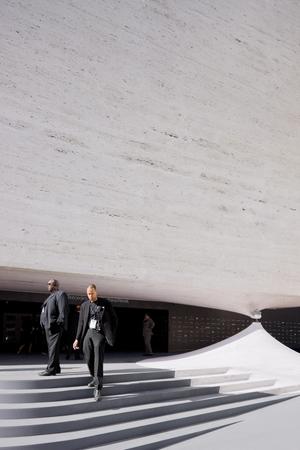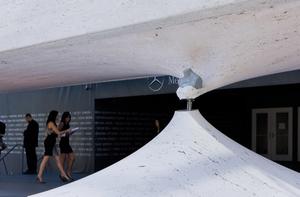
NADAATFASHIONWEEK
LINCOLNCENTERFORTHEPERFORMINGARTS
In 2010, New York Fashion Week (NYFW) made a bold and symbolic move from Bryant Park to Damrosch Park, Lincoln Center’s outdoor venue for free public concerts and an income generator for its constituent organizations. NYFW uprooted its operations from a location connected with its manufacturing past, at the edge of the Garment District, and realigned its future with the highest of high-culture platforms.
From the vantage of Lincoln Center, the arrival of a prominent player in the fashion industry was received with mixed enthusiasm. While the younger generation embraced this new player, welcoming the blurring of elite and pop culture, the older generation was uncertain about commerce infiltrating the rarefied domain of the arts. After all, could there be any stranger bedfellows than the timeless tradition of classical music and the short, fickle life cycle of fashion? Still, for two weeks out of the year, opera, ballet, and classical music audiences and performers crossed paths with designers, models, buyers, celebrities, and fashion insiders.
An encampment had to be mounted and dismounted — twice per year; once in the spring and again in the fall — to house a week’s worth of fashion performance. For those two events, the architecture of an extra constituent would assert its presence among the trio of stately institutions that surround the central fountain: the New York State Theater, David Geffen Hall (formerly Avery Fisher Hall), and the Metropolitan Opera. The fourth constituent, NYFW’s entrance marquee, would be equal to the monumental facades of its neighbors. In doing so, it would radically flirt with them, engaging their scale and material properties in an exuberant architectural dialogue.
Travertine, Lincoln Center’s signature material, was photographed, digitally printed on vinyl sheets, seamed together, and stretched over a stealthily cantilevered steel structure. The seventy-foot-high monolith would appear to hover in midair. To create this floating illusion, the marquee was supported by a double cantilever. The structure could not sit on the ground of Damrosch Park because its surface was the fragile roof of an underground parking garage. Instead, the supporting structure would have to be woven through the garage, with its concrete slabs serving as ballast, and anchored into bedrock. To make the transition from grade to the elevated floor, the same travertine language of the monolith was used to build a stepped plinth that spilled onto the plaza.
Architecture and fashion would have an unexpected intersection in the charged void under the monolith — the point of entry into the venue — where the scale of the facade converged with the scale of the human figure. Playing the role of a caryatid — a female figure in classical architecture that supports the weight of an entablature on her head — was a humanlike, robotic caryatid with no head, no arms, no legs, and no torso, but with attitude. Nada, as she was called, took on the job of connecting architectural parts, and wore a bare-midriff dress with a cropped bustier and a long flowing skirt with a seemingly endless train. Excess travertine fabric was stretched and gathered from the underside of the monolith to support Nada’s bust. A volume of fabric was draped from her hips and stretched across the plinth to the ground. Nada’s bare midriff was a key point in space between the facade and the plinth; structural loads acting in tension spread from this point in two directions. Nada’s bust and hips were dynamically activated. A microcontroller was programmed to actuate a series of servomotors driving mechanically linked gears and belts that resulted in a single, fluid motion simulating the swagger of a runway model. Nada’s weight transferred from left to right, her shoulders rotating in the opposite direction of her hips. A contrapposto pose was struck at one-minute intervals. With classic proportions, Nada coyly swished from side to side, warping the monolith with each ephemeral step.
| Location Lincoln Center for the Performing Arts, New York, United States |
| opening9th September 2010 | closed16th September 2010 |
| Team | Elizabeth Diller,Ricardo Scofidio,Matthew Johnson,Don Shillingburg,Jeremy Jih,Jose Vidalon,Alex Tseng,Hallie Terzopolos,and Michael Hundsnurscher |
| Simpson Gumpertz & Heger | Structural Engineer |
| Severud Associates | Structural Engineer |
| IMCD Lighting | Lighting |
| Sciame Construction | Construction Manager |
| Andrea Huelse, Jared Aswegan | Dress Construction |
| Marty Chafkin, Peter Kreider | Animatronics |
| Sciame | Construction Manager |




